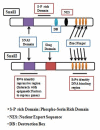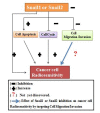Effect of modulation of epithelial-mesenchymal transition regulators Snail1 and Snail2 on cancer cell radiosensitivity by targeting of the cell cycle, cell apoptosis and cell migration/invasion
- PMID: 30655734
- PMCID: PMC6313178
- DOI: 10.3892/ol.2018.9636
Effect of modulation of epithelial-mesenchymal transition regulators Snail1 and Snail2 on cancer cell radiosensitivity by targeting of the cell cycle, cell apoptosis and cell migration/invasion
Abstract
Cancer is one of the leading causes of cancer-associated mortality worldwide. Several strategies of treatment, including radiotherapy, have been developed and used to treat this disease. However, post-treatment metastasis and resistance to treatment are two major causes for the limited effectiveness of radiotherapy in cancer patients. Epithelial-mesenchymal transition (EMT) is regulated by SNAIL family transcription factors, including Snail1 and Snail2 (Slug), and serves important roles in progression and cancer resistance to treatment. Snail1 and Slug also have been shown to be implicated in cancer treatment resistance. For resolving the resistance to treatment problems, combining the modulation of gene expression with radiotherapy is a novel strategy to treat patients with cancer. The present review focuses on the effect of Snail1 and Slug on cancer radiosensitivity by targeting cell apoptosis, the cell cycle and cell migration/invasion.
Keywords: Snail1; Snail2; cancer radiosensitivity; cell apoptosis; cell cycle; cell invasion; cell migration.
Figures
Similar articles
-
MiR-122 inhibits epithelial-mesenchymal transition in hepatocellular carcinoma by targeting Snail1 and Snail2 and suppressing WNT/β-cadherin signaling pathway.Exp Cell Res. 2017 Nov 15;360(2):210-217. doi: 10.1016/j.yexcr.2017.09.010. Epub 2017 Sep 8. Exp Cell Res. 2017. PMID: 28890291
-
microRNA-33a prevents epithelial-mesenchymal transition, invasion, and metastasis of gastric cancer cells through the Snail/Slug pathway.Am J Physiol Gastrointest Liver Physiol. 2019 Aug 1;317(2):G147-G160. doi: 10.1152/ajpgi.00284.2018. Epub 2019 Apr 3. Am J Physiol Gastrointest Liver Physiol. 2019. PMID: 30943047
-
SNAIL transcription factor increases the motility and invasive capacity of prostate cancer cells.Mol Med Rep. 2016 Jan;13(1):778-86. doi: 10.3892/mmr.2015.4585. Epub 2015 Nov 19. Mol Med Rep. 2016. PMID: 26648419 Free PMC article.
-
The EMT regulator slug and lung carcinogenesis.Carcinogenesis. 2011 Sep;32(9):1299-304. doi: 10.1093/carcin/bgr110. Epub 2011 Jun 10. Carcinogenesis. 2011. PMID: 21665887 Review.
-
Snail1-driven plasticity of epithelial and mesenchymal cells sustains cancer malignancy.Biochim Biophys Acta. 2015 Aug;1856(1):55-61. doi: 10.1016/j.bbcan.2015.05.005. Epub 2015 Jun 4. Biochim Biophys Acta. 2015. PMID: 26050961 Review.
Cited by
-
Calreticulin promotes EMT in pancreatic cancer via mediating Ca2+ dependent acute and chronic endoplasmic reticulum stress.J Exp Clin Cancer Res. 2020 Oct 7;39(1):209. doi: 10.1186/s13046-020-01702-y. J Exp Clin Cancer Res. 2020. PMID: 33028359 Free PMC article.
-
Understanding the Complex Milieu of Epithelial-Mesenchymal Transition in Cancer Metastasis: New Insight Into the Roles of Transcription Factors.Front Oncol. 2021 Nov 18;11:762817. doi: 10.3389/fonc.2021.762817. eCollection 2021. Front Oncol. 2021. PMID: 34868979 Free PMC article. Review.
-
miR-6855-5p Enhances Radioresistance and Promotes Migration of Pancreatic Cancer by Inducing Epithelial-Mesenchymal Transition via Suppressing FOXA1: Potential of Plasma Exosomal miR-6855-5p as an Indicator of Radiosensitivity in Patients with Pancreatic Cancer.Ann Surg Oncol. 2025 Feb;32(2):720-735. doi: 10.1245/s10434-024-16115-w. Epub 2024 Sep 13. Ann Surg Oncol. 2025. PMID: 39269634
-
COL8A2 Regulates the Fate of Corneal Endothelial Cells.Invest Ophthalmol Vis Sci. 2020 Sep 1;61(11):26. doi: 10.1167/iovs.61.11.26. Invest Ophthalmol Vis Sci. 2020. PMID: 32931574 Free PMC article.
-
Particulate matter promotes the epithelial to mesenchymal transition in human lung epithelial cells via the ROS pathway.Am J Transl Res. 2023 Aug 15;15(8):5159-5167. eCollection 2023. Am J Transl Res. 2023. PMID: 37692935 Free PMC article.
References
-
- Ferlay J, Soerjomataram I, Ervik M, Dikshit R, Eser S, Mathers C, Rebelo M, Parkin DM, Forman D, Bray F. International Agency for Research on Cancer. GLOBOCAN 2012 v1.0, Cancer Incidence and Mortality Worldwide. [Dec;Dec;2013 ];IARC CancerBase No.11.Globocan.iarc.fr.
-
- World Health Organization. Health Statistics and Information Systems. Database.who.int/healthinfo/mortality_data/en/ [Nov 6;2014 ];WHO Mortality.
-
- Clifton K, Gutierrez-Barrera A, Ma J, Bassett R, Jr, Litton J, Kuerer H, Moulder S, Albarracin C, Hortobagyi G, Arun B. Adjuvant versus neoadjuvant chemotherapy in triple-negative breast cancer patients with BRCA mutations. Breast Cancer Res Treat. 2018;170:101–109. doi: 10.1007/s10549-018-4727-9. - DOI - PMC - PubMed
Publication types
LinkOut - more resources
Full Text Sources
Research Materials


